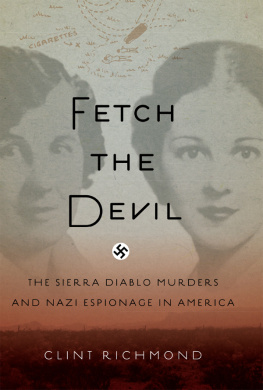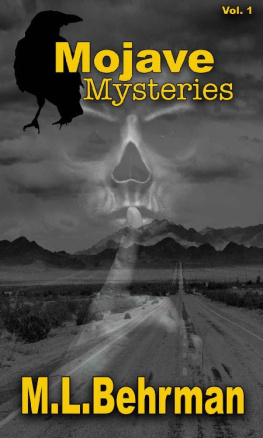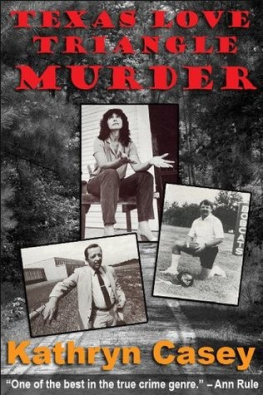Clint Richmond

FETCH
THE
DEVIL

The Sierra Diablo
Murders and
Nazi Espionage
in America
FOREEDGE
ForeEdge
An imprint of University Press of New England
www.upne.com
2014 Clint Richmond
All rights reserved
For permission to reproduce any of the material in this book, contact Permissions, University Press of New England, One Court Street, Suite 250, Lebanon NH 03766; or visit www.upne.com
Hardcover ISBN: 978-1-61168-534-3
Ebook ISBN: 978-1-61168-561-9
Library of Congress Control Number: 2013954951
Texture on title and part title pages by
HA! Designs - Artbyheather
For Judith Morison
AND IN LOVING MEMORY OF
Johanna, Jonas, and Joy

THE CHIEF WANTS YOU TO
BECOME A BAND OF ROBBERS
READY, IF NEED BE,
TO FETCH THE DEVIL FROM HELL.

Provocative challenge by an Abwehr commander under Nazi spymaster Admiral Wilhelm Canaris, when dispatching German agents on missions to foreign countries (Ladislas Farago, The Game of the Foxes).
CONTENTS
- PART I
Murder in the Desert - PART II
Spies on the Border - PART III
An Enemy Within

PREFACE

Hindsight is not only clearer than perception-in-the-moment, but also unfair to those who actually lived through the moment. Edwin S. Shneidman, Autopsy of a Suicidal Mind
I first heard of the murders near the Sierra Diablo Mountains in Far West Texas while working as a criminal-courts reporter in Dallas, in the 1960s. I was lucky to be part of a small audience of newsmen, deputies, and other courthouse denizens for some of legendary sheriff Bill Deckers rare storytelling sessions about the Depression-era bad guys he had personally faced down. He held a grudging belief that the desperados of the day lived by a code. Though they might readily use lethal force if they were cornered, or to expedite a getaway, they did not kill for thrills.
The atypical torture-murders of California socialites Hazel and Nancy Frome in 1938 were, at the time, and still remain, the biggest unsolved crime in the history of the Southwest. Sheriff Decker, like almost every Texas lawman of the period, played a part in that sweeping investigation.
Generations of Texas newsmen have revisited the mystery, including one of my editors when I was a reporter at the Dallas Times Herald. Felix McKnight, then the papers executive editor, had looked into the case in the 1940s, as a young reporter himself, and concluded it might never be solved.
Little did I know that, when Sheriff Decker was regaling us with tales of his encounters with Bonnie and Clyde and his capture of the notorious cop killer Raymond Hamilton, the Frome murders would become such a time-consuming quest of my own writing career at the turn of this new century.
In late March 1938, the California matron and her beautiful daughter set out alone on a cross-country drive from their Bay Area home to the East Coast, with scant regard for the dangers lurking on the highways they would traverse. They soon became the most famous victims of that era.
The brutal torture and murders of Hazel Frome and her sorority-president daughter Nancy in the desert east of El Paso baffled local sheriffs, Texas Rangers, and federal agents for decades.
New evidence, gleaned from several sources unavailable until long after the womens near-nude bodies were found, is compiled and compared in this book for the first time, to provide a plausible answer to this more than seven-decades-old mystery.
Law enforcement officers working on the Frome murder case were largely unaware of information gradually building in the files of federal agencies about the Nazi spy network operating under deep cover in the western United States. The investigators certainly had no knowledge that these clandestine activities could have been linked to the crime.
In building this story I had the advantage of hindsight gained through the declassification, in the late 1990s, of secret government files. Access restrictions were lifted after my own Freedom of Information Act (FOIA) requests regarding specific individuals and events pertaining to preWorld War II Axis spying. My requests covered old files of the FBI, the Justice Department, the immigration service, and military intelligence agencies. I also found considerable relevant information about persons believed to be involved in the Frome murders in the archives of the criminal division of the American Medical Association (AMA).
Also of significance to this case were the voluminous Nazi spy files seized after the war and shipped in crates from Germany to the National Archives in Washington, D.C. This rich source of information was not made public until 1967, when military historian and journalist Ladislas Farago stumbled across the cache of Abwehr documents after a decade of research.
My chance discovery, in 1995, of a massive, forgotten cold-case file personally penned by the original Frome case coordinator, the late sheriff Chris P. Fox, and carefully stored at the El Paso Sheriffs Office, offered the final pieces needed to provide the link between the murders and Nazi espionage activities.
In fairness to those Old West lawmen who so diligently worked to solve the Frome case, connecting the murders to unknown German espionage operations from California to the Texas-Mexico border would have been impossible in the late 1930s and early 1940s, indeed, until long after the end of World War II.
Only in recent years, after files in the possession of the U.S. government were declassified, was I able to connect the germane incidents described in this book that were occurring contemporaneously in El Paso, Mexico, Los Angeles, and the San Francisco Bay Area at the time of the murders. The newly revealed associations, mostly unintended, between the Frome familys fate and subversive Nazi elements, became too numerous to be simply coincidental.
Clint Richmond

AN UNFORGIVING PLACE

Her pampered skin was more accustomed to the caress of perfume than the rivulets of hot, wind-driven desert sand abrading her naked back. Only two weeks earlier the beautiful young woman had been dancing in the arms of admiring suitors at the spring ball of her Bay Area sorority.
A large-eared pack rat darted back and forth from the safety of its midden-lined nest in a nearby crag, to tug at the glinting diamond wristwatch that the older woman wore on her left arm. The rodent was answering some inexplicable instinct to collect such bright trinkets to decorate its burrow, more driven by primordial addiction than fear of approaching the human corpses intruding on its natural habitat.
The journey of Nancy and Hazel Frome, missing four days on their coast-to-coast schedule, had ended in this shallow caliche pit in the Chihuahuan Desert, six miles east of the hamlet of Van Horn, Texas.
The great desert covering much of northern Mexico and Far West Texas is an unforgiving place for those who enter unprepared. In all seasons, a relentless sun makes for searing days that rapidly turn to freezing nights, soon after it sets. The extremes of temperature swung that day, on April 3, 1938, in a violent pendulum of more than fifty degrees, enough to cause tiny, eroding fissures in rock surfaces.
Next page















